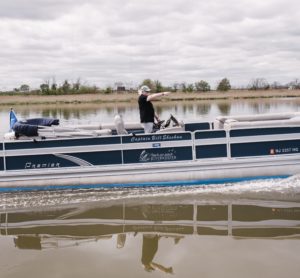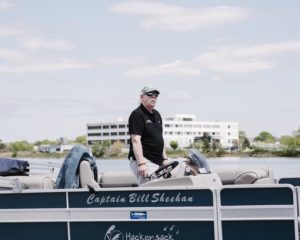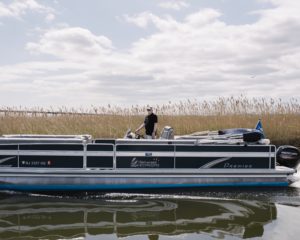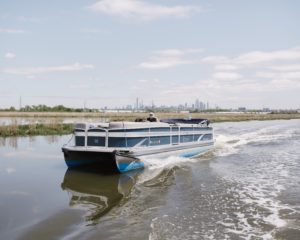Jersey Boy | Captain Bill Sheehan, Hackensack Riverkeeper
By: ajcarapella
For three decades, Captain Bill Sheehan has skillfully steered a movement to clean up and protect his native river and wetlands.

By Lisa W. Foderaro.
Photos by ©John Francis Peters, courtesy of Culture Trip.
As a kid growing up in northern New Jersey in the 1960s, Bill Sheehan bounced from one town to another. There was a basement apartment in a farmhouse in the north end of Secaucus, a rental hard by the Pulaski Skyway in Jersey City, and a four-story walkup in Union City. Over the years, he attended six grade schools and two high schools.
“My dad was a longshoreman and barge captain and they were always chasing rent,” Bill says of his parents. “Wherever we could get the best deal, that’s where we would move.”
But there was one constant: the Hackensack River. Flowing 45 miles from suburban Rockland County, New York, to Newark Bay in New Jersey, the river formed the backdrop of his youth and the spine of the Meadowlands, long considered one of the largest and most polluted wetlands in the New York region.
Sixty years ago, during Bill’s childhood in Secaucus, there were more hog and vegetable farms along the Hackensack than industrial sites. Still, it was hardly the idyllic backdrop of a post-World War II American boyhood.
“In those days, if you didn’t have school, your parents would tell you to go out and play,” he remembers. “But they also said, ‘Stay away from that damn river.’ The water was horrible. It stank. It smelled like raw sewage and there were dead animals in the river. That was one thing the farmers would do. If they had a dead horse or a dead hog, they’d throw it in the river.”
He and his friends figured out ways to play along the Hackensack anyway. They climbed inside giant cardboard boxes and rolled along the riverbanks, flattening the tall phragmites as they spun. They explored makeshift trails that snaked along the shore. And as Bill grew older, he ventured south by boat into Newark Bay and on to Raritan Bay, where he fell in love with fishing.
It was fishing that, decades later, would take him back to the Hackensack River – and into his current act as the river’s chief protector and advocate.
PHRAGMITES, GARBAGE, AND JIMMY HOFFA
The Meadowlands is known to many who drive on the New Jersey Turnpike as a vast sea of phragmites, or common reeds, west of the Hudson River, where the Hackensack meanders in the distance. These wetlands are where the body of the controversial Teamsters union chief Jimmy Hoffa is rumored to be buried, and where, for many years, public officials and developers saw only a worthless swamp dotted with garbage dumps.
“If somebody had come along and had an idea to fill the whole thing in with concrete and build officer towers on it, they would have said, ‘Thank goodness,’” Bill says, only half-joking.
By 1969, some 5,000 tons of garbage a day were being dumped in the Meadowlands from 118 New Jersey communities and New York City. Heavy industry was also in full swing, with more than a dozen plants, including Standard Chlorine, Universal Oil Products and Scientific Chemical Processing, making or processing inks, chlorine, mercury and oil, among other chemicals, on the Hackensack River and its tributaries. They left behind hundreds of acres contaminated with PCBs, dioxins and other toxins, and by the 1980s, the U.S. Environmental Protection Agency had designated several of the former factories Superfund sites.

Before heavy industry swept across it, the Meadowlands was an important source of salt hay. According to “The Meadowlands: Wilderness Adventures on the Edge of a City” by Robert Sullivan, salt hay farmed there was used from the 1700s to mid-1900s in stables and icehouses, as well as in the manufacture of bricks, glass, crockery and asphalt. And a dense forest of white cedar had covered nearly half of the Meadowlands, its straight-grained wood valued for boatbuilding and roof shingles.
On a tour of the Hackensack River with local high-school students last summer, Captain Bill, as he is nicknamed — he holds a 25-Ton Launch/Tender Master’s license from the U.S. Coast Guard — navigates a pontoon boat south along the river from Carlstadt, N.J., past the old, the new and the timeless. There are rusted rail bridges stuck in an upright position, obsolete telegraph towers and abandoned factories, along with shiny hotels, office complexes and the occasional marina. Turning into one of the many side channels, Bill shows the students the nature that persists – indeed, thanks in no small part to his efforts, today thrives – in the Meadowlands.
Red-winged blackbirds belt out a raspy trill from the reeds, while snowy egrets and black-crowned night herons forage for food in the mud. A diamondback terrapin scuttles into the water from a rock as our boat approaches.
“The species-list for the Meadowlands is hovering around 275 species of birds during the course of the year and 70 species of marine life,” Bill says proudly. “The water quality is better now than it’s been at any time in my lifetime, for sure.”
DRUMMER, DISPATCHER, RIVERKEEPER
Before Bill, who is 69, became an environmental crusader, he was a drummer. Even now, if you squint at his handlebar mustache, shark-tooth pendant and arm tattoos, you can see the rocker who started playing gigs in local nightclubs at age 15. He kept playing into the 1970s. “When disco took over, I got out of the business,” he says. “All the bars wanted to hear disco, and I was a drummer. I wasn’t a rhythm machine.”
While he was “waiting for disco to die out,” Bill drove a taxi, then became a dispatcher for a cab company in Union City. By that time, he was on his second marriage and his drumming days were fast receding in the rearview mirror.
“You know, it was a job,” he says of the taxi industry. “But it gave me the opportunity to buy a boat.”

For some reason, Bill was always drawn to pontoon boats, those somewhat clunky, flat-bottomed craft that rely on two cylindrical tubes to float. By the mid-1980s, he had worn his wife down with his endless talk of their charms. One day, she told him to just go buy one. “I called up my nephew,” Bill recalls, “and said, ‘Before she changes her mind, we are going boat-shopping.’”
“I was fascinated by the idea that this guy was riding around San Francisco Bay, taking names, suing polluters and kicking ass. I was like, ‘Wow, that’s a great job. How do you get a job like that?’”
That purchase, in 1986, enabled Bill to indulge his passion for recreational fishing. Although he was still working 12- hour days for the taxi company, he started spending what free time he had with a rod and reel out on the water. When it rained, well, he’d “turn on the TV and watch other people fish.”
And on a fateful Saturday morning in 1988, when Bill’s TV was tuned to ESPN, his career as Hackensack Riverkeeper was born. Between programs about fishing, there were short profiles of people who had managed to make a career of the outdoors, and Bill learned about Michael Herz, founder of San Francisco Baykeeper, which was the fourth Waterkeeper organization formed, after Hudson Riverkeeper, Long Island Soundkeeper, and Delaware Riverkeeper.
“I was fascinated by the idea that this guy was riding around San Francisco Bay, taking names, suing polluters and kicking ass,” he says. “I was like, ‘Wow, that’s a great job. How do you get a job like that?’”
But life was busy and Bill put the idea on hold, until a few years later, when he came across an article in The Fisherman magazine about NY/NJ Baykeeper, which was looking for volunteers. He soon joined the group’s boating auxiliary.
“If there was a pipe and you didn’t know what it was, you would take a picture and send it to Baykeeper and say, ‘What’s this?’ ” he recalls. “Because my boat was on the Hackensack River, I became the eyes and ears in the Meadowlands.”
It wasn’t long before Bill had the idea of forming his own group focused entirely on protecting the Hackensack. He started small, with a nonprofit group called “Hackensack Estuary and River Tenders,” or HEART. But Andy Willner, founder of NY/NJ Baykeeper, urged him to become an official Riverkeeper, so Bill reached out to John Cronin, who was then Hudson Riverkeeper, and in 1997 received permission to use the Riverkeeper trademark.
By then, the passage of the federal Clean Water Act, in 1972, had resulted in the building of sewer systems in Secaucus and many other cities, so the river no longer emitted swoon-inducing odors. But industrial pollution was at an all-time high, along with other threats to the remaining acres of wetlands. Bill set to work taking on one polluter and developer after another, often with the help of the Rutgers Environmental Law Clinic, which was later folded into the Eastern Environmental Law Center.
An early victory involved Hartz Mountain Industries, a major developer in the Meadowlands. After the company bought up acres of wetlands, it hatched a plan in the 1980s to fill in Mill Creek Marsh and build about 2,800 townhouses. Bill’s relentless campaign against the project eventually turned residents and officials in Secaucus against it as well.
“It was the first time Secaucus stood up to Hartz Mountain,” he recalls. “The residents were concerned about the quality-of-life impacts, and I was concerned about the river. Wetlands are our kidneys. They filter stormwater and they provide buffers against floods, as well as wildlife habitat.”
After years of legal and regulatory challenges, Bill and his lawyers prevailed. In the 1990s, Hartz Mountain sold the land to the Hackensack Meadowlands Development Commission, which restored it into a 209-acre wetland preserve called Mill Creek Marsh Trail. “Now we have a mile and a half of trails and it’s open to the public,” Bill says.
“I WILL THROW LAWYERS AT YOU LIKE A BAG OF HAMMERS.”
Sitting on one of Riverkeeper’s two pontoon boats docked on the Hackensack in Carlstadt’s River Barge Park, Bill talks about that battle and others — including those against Honeywell International, Standard Chlorine and the Mills Corporation, a shopping-mall developer – with the nostalgia of a boxer reviewing his epic moments in the ring. He has stopped massive real-estate developments from rising on the wetlands and forced corporate polluters to take on complex, costly cleanups of former industrial areas. As with the Hartz Mountain development, he also has often walked away with a donation of parkland or money. Several years ago, for instance, he got a tip that a hotel was dumping raw sewage into the river. It turned out that the pipes under the hotel had collapsed, and instead of proper repairs being made, tunnels had been dug that led to a large pit from which sewage-contaminated wastewater was pumped into the Hackensack.
“Luckily, I was at a point in my career where I understood the difference between a criminal violation and a civil violation,” recalls Bill, who called the state Attorney General’s office. A week later, agents raided the property and charged the hotel owner with violating the Water Pollution Control Act. The owner pleaded guilty in state court and, as part of a plea deal, made a $75,000 donation to Hackensack Riverkeeper.
“People have to understand that I’m not fooling around with this,” Bill says of his pugnacious advocacy. “I’m not here to play nice. When I have to be that bad guy – look out! I will get as many lawyers as I need and I will throw them at you like a bag of hammers.”
Former NY/NJ Baykeeper Andy Willner says Bill seems to have been born for the role of Hackensack Riverkeeper.
“From day one, there was no stopping him. He’s a natural advocate. He very quickly became an extraordinary public speaker and one of the most knowledgeable naturalists I know.”
Just as important as fighting polluters was building a constituency for the river.
“All the challenges I’ve talked about are really not unusual,” Bill says. “If you talked to 100 Waterkeepers, you’d probably find that 99 of them have many of the same issues. The biggest problem that I have is the location of the Hackensack River” — meaning in the middle of the historically blighted Meadowlands — “and the fact that nobody had a relationship with it.”

So, in 1999 he started renting canoes and kayaks, first at Laurel Hill Park in Secaucus and later at Overpeck County Park in Bergen County. Between the rentals and the river cruises aboard the pontoon boats, about 10,000 people a year now explore the river.
While the organization charges as little as $15 for a two-hour kayak rental, the income adds up, enabling Bill to hire 25 summer seasonal workers. Rental income, grants, and donations have brought in more than $10 million since Hackensack Riverkeeper’s inception. It now has an annual budget of $800,000 and six full-time employees.
To illustrate how far the group has come in its quest to create a constituency, Bill shares an anecdote from his early years fighting for the Hackensack. It was the mid-1990s, when he was still volunteering for NY/NJ Baykeeper, and he was meeting Anthony Just, then mayor of Secaucus, for the first time. “I walked into his office and said, ‘I want to talk to you about the river,’” he remembers. “And he looked at me and said, ‘What river?’ I said, ‘What river? What river goes through this town? The Hackensack River!’”
“The biggest problem that I have is the location of the Hackensack River — meaning in the middle of the historically blighted Meadowlands — and the fact that nobody had a relationship with it.”
Bill says a critical milestone came in 2004 when the New Jersey Meadowlands Commission developed a new master plan to rezone the remaining 8,400 acres of wetlands for conservation. (An equal area had already been lost to development or the creation of garbage dumps.) Now, all but 200 of those saved acres belong to the State of New Jersey or the Meadowlands Conservation Trust, which Bills chairs.
As much as Bill enjoys recounting past progress, he spends more time pondering the work that remains, attacking problems that include contaminated sediment on the river bottom and combined sewer overflows, which happen when waste-treatment plants handling both stormwater and sewage are overwhelmed by rain and must discharge everything into the river untreated. During the Obama administration, Bill petitioned the Environmental Protection Agency to determine whether the lower part of the Hackensack qualified for inclusion on the National Priorities List, known commonly as the Superfund list. After taking 400 core samples and reviewing pertinent literature, the EPA agreed that it did. A listing as a Superfund site could have yielded significant money from former polluters, but the New Jersey Department of Environmental Protection, under Gov. Chris Christie, refused to sign off.
“Christie didn’t want the river listed as a Superfund site on his watch,” observes Bill, who is now trying to convince environmental officials in the administration of Gov. Phil Murphy to approve a listing. “If I had to go after each of the companies that polluted this river, I would have to live to be 700 years old. By getting it listed, the remedial work might not be done in my lifetime, but they’ll be working on it. Eventually it will get cleaned up to the point where people can eat the fish again and not worry about getting in the water. That’s our goal.”
In addition to everything else Bill has mastered as Hackensack Riverkeeper, from carcinogenic compounds to litigation strategies to public relations, he has also learned to adjust his sense of time.
“A lot of the projects don’t happen overnight,” he says. “Being in the taxi business, I was on a five-minute schedule – always. ‘Okay, I’ll be there in five minutes. Be there in five minutes.’ When I got into this business, I had to ratchet it back. Now it’s: ‘In a couple of years, or maybe 20 years. But it’ll get done.’”
Lisa W. Foderaro was a staff reporter for The New York Times for more than 30 years and has also written for National Geographic, Audubon Magazine, and Adirondack Life.